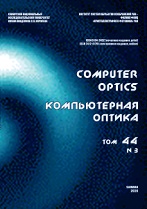|
Эта публикация цитируется в 2 научных статьях (всего в 2 статьях)
ОБРАБОТКА ИЗОБРАЖЕНИЙ, РАСПОЗНАВАНИЕ ОБРАЗОВ
A parallel fusion method of remote sensing image based on NSCT
X. Xue, F. Xiang, H. Wang
The School of Computer and Information Engineering, Anyang Normal University, Anyang 455000, Henan, China
Аннотация:
Remote sensing image fusion is very important for playing the advantages of a variety of remote sensing data. However, remote sensing image fusion is large in computing capacity and time consuming. In this paper, in order to fuse remote sensing images accurately and quickly, a parallel fusion algorithm of remote sensing image based on NSCT (nonsubsampled contourlet transform) is proposed. In the method, two important kinds of remote sensing image, multispectral image and panchromatic image are used, and the advantages of parallel computing in high performance computing and the advantages of NSCT in information processing are combined. In the method, based on parallel computing, some processes with large amount of calculation including IHS (Intensity, Hue, Saturation) transform, NSCT, inverse NSCT, inverse IHS transform, etc., are done. To realize the method, multispectral image is processed with IHS transform, and the three components, I, H, and S are gotten. The component I and the panchromatic image are decomposed with NSCT. The obtained low frequency components of NSCT are fused with the fusion rule based on the neighborhood energy feature matching, and the obtained high frequency components are fused with the fusion rule based on the subregion variance. Then the low frequency components and the high frequency components after fusion are processed with the inverse NSCT, and the fused component is gotten. Finally, the fused component, the component H and the component S are processed with the inverse IHS transform, and the fusion image is obtained. The experiment results show that the proposed method can get better fusion results and faster computing speed for multispectral image and panchromatic image.
Ключевые слова:
image fusion, remote sensing image, panchromatic image, multispectral image, nonsubsampled contourlet transform, IHS transform, parallel computing.
Поступила в редакцию: 13.06.2018
Принята в печать: 09.12.2018
Образец цитирования:
X. Xue, F. Xiang, H. Wang, “A parallel fusion method of remote sensing image based on NSCT”, Компьютерная оптика, 43:1 (2019), 123–131
Образцы ссылок на эту страницу:
https://www.mathnet.ru/rus/co612 https://www.mathnet.ru/rus/co/v43/i1/p123
|

| Статистика просмотров: |
| Страница аннотации: | 131 | | PDF полного текста: | 66 | | Список литературы: | 29 |
|




 Обратная связь:
Обратная связь: Пользовательское соглашение
Пользовательское соглашение
 Регистрация посетителей портала
Регистрация посетителей портала Логотипы
Логотипы








 Цитирование в формате
Цитирование в формате 
